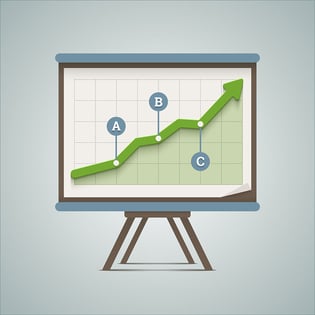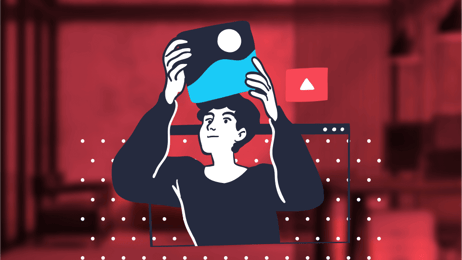If your website and other areas of marketing technology are a major headache, you're far from alone.
Recent surveys of marketing pros report that IT and website-related woes are the single most common pain point reported by today's marketing teams, with 54% describing it as a "bottleneck." Testing and optimization came in second, causing stress for some 47%.
Today's marketing teams understand all too well that their efforts to create engaging content and fantastic email marketing may go to waste if their website is woefully out-of-date. Studies indicate that over 90% of consumers may feel "uneasy" about a brand solely based on their website experience. Consumer expectations for a positive user experience, including website navigation, page load times, and mobile-optimization, are quickly changing. If your site fails to provide an adequately modern experience, your prospects could dismiss your brand entirely before even exploring your inbound marketing materials.
Growth Driven Design vs. Traditional Website Design
Google Vice President Sridhar Ramaswamy recently took to the Wall Street Journal to talk about recent "seismic change[s]" in the marketing realm. Delayed gratification is no longer a reality for the 2 billion adults worldwide who own a smartphone. It's now possible to book an entire vacation to Italy while waiting for your lunch to be prepared at a fast casual dining chain. Modern consumers have the ability to research products and make purchase decisions on mobile devices throughout their day; a concept Ramaswamy refers to as "micro-moments."
Modern consumers move very quickly, which is why brands can't afford to let their website go out-of-date. The average company today only invests in a new design every three years. The climate of quickly-moving, mobile consumers has precipitated a need for real-time, data-driven website updates, also known as growth-driven design (GDD).
GDD allows brands to treat their website like the living asset that it is. Instead of investing budget into a full site rebuild every several years, you're able to use marketing analytics to develop priorities and make improvements on a continual basis. This ensures that your site never goes entirely out-of-date, and you're able to optimize for zeitgeist, or what your prospects want right now.
To learn more about GDD, we recommend What Does Growth Driven Design Mean?
In this blog, you'll learn the pros and cons associated with both GDD and traditional web design, as well as a total estimated cost of each approach to web development.
Traditional Website Design
To be clear, conventional web design is the right option for some brands. Companies with fantastic marketing momentum and a dated website may choose to invest in a one-and-done development approach. If you have more than 10,000 monthly visitors and exceptional marketing assets that don't include excessive paid search, traditional web design might be the right option for you.
Before you make a decision, here are the pros and cons of this approach to redesigning your company's website:
Pros of Traditional Web Design
Brands understand the outcome of a traditional web design project. When engaging with an inbound web agency or their internal tech team, they have a strong understanding of project timelines after completing the requirements gathering phase. The pros of this approach include:
- It's a self-contained project with a well-defined finish line, as opposed to ongoing efforts
- It's familiar, and what most people think of when they think of website design or redesign.
Cons of Traditional Web Design
While traditional web design can offer a familiar experience for brands, there are significant disadvantages associated with the process. In fact, the typical approach to web design can present a "great deal of systemic risk" and the potential for missed opportunities.
Websites carry an expiration date of approximately 6-24 months; though this can vary according to industry and buyer personas.While your mileage may vary, brands often find that traditional web design processes can carry the following cons:
- Significant up-front cost investment
- Time commitment of 3-6 months until the product is finished
- Resulting design is based on assumptions of your buyer's journey that could be wrong
- Design timelines and project scope can shift if your requirements change mid-design
- Your website is subjective, and may not be based on marketing analytics and data
- Will begin going obsolete as soon as it's launched
Is traditional web design the right solution for some companies? Absolutely. For brands with serious marketing mojo, a high volume of website visitors and a fantastic, data-driven understanding of their buyers' journey, traditional web design can be the right solution. However, for companies without sufficient marketing analytics or buyers' journey knowledge to design the right web experience, the product of traditional web development can miss the mark.
How Much Does Traditional Web Design or Redesign Cost?
Pricing for a website design project can vary significantly according to the following factors:
- User experience and navigation
- Design complexity
- Content editing, creation, and revision
- Content management system selected
- eCommerce and payment integrations
- Functionality and interactivity
- Mobile optimization
The complexity of each of these factors can increase the time investment required for your website redesign, which can increase costs. A ballpark cost output for a well planned web design project will likely fall between $15,000-$100,000; though most brands find their pricing is in the $25,000 - $50,000 range.
Growth Driven Design
If your company needs to simultaneously focus on marketing and website improvements, growth driven design might be the right solution. This approach allows you to divide your budget and time between improving your inbound marketing strategy and website while developing a better understanding of your prospects' preferences and buyers' journey.
If your monthly website visitors are between 1 and 10,000, growth driven design is a powerful way to maximize your marketing budget. If you select this approach, your brand will focus on first creating a simple launchpad website. Once the launchpad is complete, you'll launch monthly improvements based on your team's priorities and your marketing analytics.
Here are the pros and cons of GDD:
Pros of Growth Driven Design
GDD takes an agile approach to ensuring your website never goes out of date, by prioritizing monthly improvements. This ensures that you're able to keep up with the quickly changing preferences of consumers, and optimize your site for your buyer personas. Pros of this approach include:
- Launch a new design in far less time for far less cost (50% faster and 50% cheaper, on average).
- The ability to measure, learn and optimize based on real data
- The power to tweak and change the website as buyer behavior changes
- There is no large up-front cost investment, as cost is spread out over months
- Continual improvements ensure your website is never entirely out-of-date
- Return on investment since your design is based on user data
Cons of Growth Driven Design
GDD is an entirely unfamiliar concept for many companies, which are used to technology initiatives being self-contained projects. The idea of committing to monthly spend can be surprising to others, who are used to thinking of web design as a stand-alone, occasional expenditure. The cons of this approach include:
- The project is ongoing, which could bother brands who prefer a hard project deadline
- GDD is a new approach to continuous website improvement
While the agile methodology and continuous improvement cycling aren't entirely new concepts, GDD is a more recent application of these ideas. While the approach is new, it's based on the time-tested concept of applying feedback throughout the development process. The "newness" of GDD will almost certainly cease to be perceived as a con as more brands adopt this approach.
How Much Does Growth Driven Design Cost?
There are both fixed and variable costs associated with growth driven design. Before you can begin this approach, you'll need to develop a launchpad website as a basis for improvement. Launchpad websites typically cost $10,000-$40,000, with most brands landing between $15,000-$25,000.
After the development of your launchpad website, the cost of GDD can vary according to several factors, which primarily include your brand's website needs, your marketing analytics, and your budget. Companies with less than 5,000 monthly website visitors may choose to invest $1,000 to $2,500 monthly in GDD, saving budget for building traffic and leads.. Companies with 10,000 organic website visitors monthly and above may budget closer to $5,000.
Depending on your brand's unique needs, the monthly cost of GDD is typically between $1,000 and $15,000, though most established brands fall in the $2,500-$7,500 range.
Is Growth Driven Design For You?
Ultimately, having a website that elicits trust, not uneasy feelings, in your prospects is priceless. Marketers today struggle with web technology as a major pain point and having a website that meets consumers' quickly changing needs is a crucial tool for competing. Regardless of whether you believe traditional web design or GDD is right for you, committing to keeping up with your prospect's preferences and expectations is necessary.




